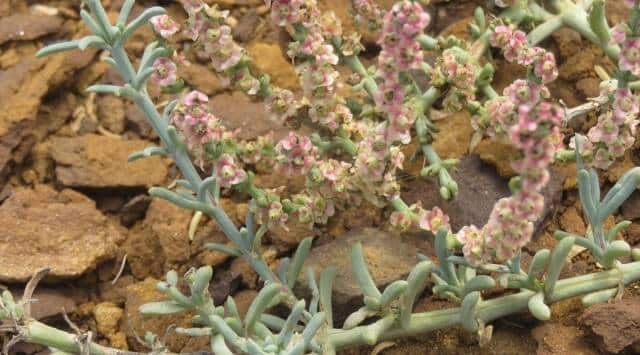About Salsola Oppositifolia Desfontani:
- It is a species that belongs to the family of Amaranthaceae.
- Features
- It is a perennial shrub that grows in saline, arid to semi-arid environments.
- It is a succulent shrub that can grow one to two metres tall and have a smooth, cylindrical, woody base.
- It is rarely prostrate and unlike other species of Salsola, does not have any hairs.
- As the name oppositifolia suggests, the leaves of this plant grow opposite each other in the stem.
- It is a halophyte plant -a plant adapted to growing in saline conditions.
- This species, earlier known from Italy, Northern Africa, Palestine, Spain and Western Sahara.
- It has been reported for the first time from India based on the collection made from Khadir Bet, Kutch, Gujarat at 15.5-m altitude.
- It is the sixth species of Salsola genus to be discovered in India.
- Five other species of Salsola genus which have been recorded in India are Salsola kali, Salsola hatmanii, Salsola monoptera, Caroxylon imbricatum (Salsola baryosma) and Halogeton glomeratus (Salsola glomerata).
- Plants of the Salsola genus have salty juice stored in their leaves.
- Uses
- Salsola oppositifolia is used as a raw material for manufacturing soda ash.
- Other Salsola species are used in manufacturing lye and soaps.
- Research has established that the species of this genus are rich in pharmacological properties also.
Q1) What are Halophytes?
Halophytes are plants that are adapted to thrive in high-salt environments, such as saltwater marshes, coastal areas, and salt flats. These plants have evolved unique physiological and biochemical adaptations that allow them to tolerate and even utilize the high levels of salt in their surroundings.
Source: New plant species that grows in saline conditions of Kutch discovered
Last updated on June, 2025
→ UPSC Notification 2025 was released on 22nd January 2025.
→ UPSC Prelims Result 2025 is out now for the CSE held on 25 May 2025.
→ UPSC Prelims Question Paper 2025 and Unofficial Prelims Answer Key 2025 are available now.
→ UPSC Calendar 2026 is released on 15th May, 2025.
→ The UPSC Vacancy 2025 were released 1129, out of which 979 were for UPSC CSE and remaining 150 are for UPSC IFoS.
→ UPSC Mains 2025 will be conducted on 22nd August 2025.
→ UPSC Prelims 2026 will be conducted on 24th May, 2026 & UPSC Mains 2026 will be conducted on 21st August 2026.
→ The UPSC Selection Process is of 3 stages-Prelims, Mains and Interview.
→ UPSC Result 2024 is released with latest UPSC Marksheet 2024. Check Now!
→ UPSC Toppers List 2024 is released now. Shakti Dubey is UPSC AIR 1 2024 Topper.
→ Also check Best IAS Coaching in Delhi






















